Issue 2, March 1984 - Printer Interfaces
| Home | Contents | KwikPik |
| YS HARDWARE REVIEW: |
all the data is re-routed through one of
the OUT ports to the interface. On
their way, each of the characters
passes through a 'code converting'
routine held somewhere in memory.
While the normal alphanumeric codes
closely follow the standard ASCII
set, all the control codes, pre-defined
graphics and Basic tokens must be
intercepted. In the case of the tokens,
these are converted back into strings
of ASCII letters before being listed.
Because many of the currently available printers use sequences of control
codes to change character fonts or to
select graphics, provision must also
be made to allow these codes to be
sent without being trapped. The test equipment to which the various interfaces were connected comprised a Tandy CGP-115 four- pen plotter printer and an Epson FX-80 dot matrix printer. Unfortunately, the Epson turned out to be 'Dead on Arrival' and the author's Apple Dot Matrix Printer was substituted. As this printer is based on a TEC chassis, it proved impossible to check the graphics dump facilities on all but one of the interfaces. However, there is no evidence to suggest that the software provided wouldn't operate correctly with the appropriate hardware and indeed, the Kempston interface unit has been seen elsewhere to function perfectly with both the RX-80 and FX-80 printers. | |
|---|---|---|
|
G E T T I N G I N T O P R I N T | ||
| Good as it is for the price, many users are bound to be disappointed with the output from Sinclair Research's own printing device. For those toying with the idea of upgrading their Spectrum system with a professional printer, Henry Budgett takes an in-depth look at the technology involved and the plethora of interface devices now available. |
Kempston Centronics Interface
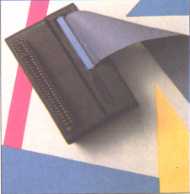
Hardware: A very neat and specially designed casing houses the single printed circuit board. Featuring just two ICs (an 8255 and 4071) the unit is constructed from high quality components and mounts vertically behind the ZX Spectrum, contact being made through a gold-plated edge connector. No provision has been made for other units to cascade from the rear of the interface. The interface cable is detachable but not keyed at the interface end; it might therefore be possible to connect it upside down. Manual: The accompanying documentation consists of just four pages, A5 sized. All the necessary | |
|
Regardless of what one actually
thinks about Sinclair Research's ZX
Printer, it's impossible to ignore the
fact that it really does work. For the
price and performance that it offers
there's no equal anywhere. But despite that, there are users who need
something a little more professional.
Software houses developing programs, small businesses using the ZX
Spectrum or just a serious user who
demands something better than a
sheet of aluminised paper that is, at
best, just legible after a few days'
handling. We're fortunate in having a number of commercially available interface units that allow the ZX Spectrum to be connected to the growing range of low-cost printers. In the main, these units convert the signals provided on the expansion connector into those which conform to the industry standard Centronics interface. There are two stages to this conversion: that of altering the electrical characteristics |
of the output from the ZX Spectrum
and that of converting the character
codes from Sinclair Research's own
internal format to true ASCII. The alterations to the electrical signals are handled in a variety of ways by the interfaces reviewed here; some use very sophisticated chips to handle the work, others tackle the task by using more of the simple ICs. Only one of the interfaces in this review offered the possibility of connecting to a serial printer but, in theory at least, the problems involved are tackled in much the same way. All the interfaces were supplied with software drivers of one sort or another (see the individual panels for further details) and in general, these all work by intercepting the ZX Spectrum's printer routine vector. This is the location in memory that stores the address of the routine which controls data being sent to the printer by LLIST and LPRINT. By changing this address to that of the new driver | |
Software: Four programs are provided on cassette to support the interface and all reside in the printer buffer when loaded. The main program is a simple text-only driver which supports LLIST, LPRINT, PRINT AT, TAB AND ','. All the standard ASCII characters are coped with and all keywords are de-tokenised; control codes can be sent by LPRINTing the appropriate CHR$(x). In addition to these standard features the software supports a TEXT COPY, called by RANDOMIZE USR 23370, and allows the number of characters per line to be set. Also included, and very useful too, is the facility to enable or disable the Line Feed character after each Carriage Return. Kempston also provides, on the same tape, three high resolution copy programs. These effectively replace the text driver's TEXT COPY with a screen graphics copy, all other facilities remaining the same. The first program is for all the standard Epson printers, but programs for the Seikosha GP80/GP100 and the Seikosha GP250X are also provided. Price: £45.00 all inclusive. Summary: An excellent product and one which, in a commercial software environment, has proved to be totally reliable. The instructions are short and sweet, no problems would be encountered by even the newest of newcomers. Euroelectronics ZX LPRINT MkII 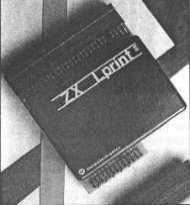
Hardware: This unit was the only horizontally fitted interface of the range under review. A single PCB is sandwiched inside a small, standard 'plotting' box; the result is not particularly attractive. A detachable ribbon cable, just over one metre in length, plugs on to the rear of the unit and although no key is provided at the unit end, it would be difficult to plug it in |
the wrong way around. On the review
sample, the plastic frame of the PCB-
mounted header had been cracked but
no problems resulted. Interestingly, this interface does the COPY processing internally - a ROM contains suitable software for the printer chosen. Of the six remaining ICs, two had had their idents removed and as they all appear to be common devices, the reason may be that they are rejects - which could bode ill for long-term reliability. Manual: It seems almost churlish to call a single side of A5 paper a manual! However, further information is provided 'on-screen' once the software is loaded. Interestingly, there is no mention of LLIST anywhere, yet it works! Software: The driver consists of a short (109 byte) routine that forces itself to the top of memory and then resets RAMTOP. All the rest of the processing is carried out by the ROM in the interface. To prove that it really works, the tape includes a demo picture to dump - one of those highly magnified views of a pimple! The COPY program supplied with the review sample was suitable for driving the Epson range as well as the Star DP510 and 515 printers and the Shinwa CP80. Alternative software is available for the Seikosha GP100 and GP250X printers, the Microline series and the latest offering is for the Tandy CGP-115 and MCP40 printer plotters which can provide (very slowly) copies in four colours. A new version of the interface is due out shortly with a range of software built in as standard. Price: £34.50 plus £10.45 for the cable. Summary: Despite its rather shabby looks, the LPRINT worked well and the provision of software in ROM makes for faster operation. When your author passed comment on its appearance to a friend he replied that he expected interfaces to look like that! The price of the cable is very high and it might be worth making your own. But apart from that it offers good value for money. Morex Peripherals Centronics/RS232 Interface Hardware: The vertically mounted box is functional rather than attractive, and the cut-out appears at first sight to have been made by a hungry rabbit! Even more important than mere aesthetic quality is the fact that the casing partially covers the power socket on the ZX Spectrum; also, the plug has to be forced in and is very prone to dropping out again. As far as design goes, this doesn't. However, the unit was also the only one in the survey to allow other units to be |
attached in cascade - although the
way in which the edge connector is
soldered leaves a little to be desired. Inside, however, the circuitry consists of just four ICs, which is a very compact design considering the inclusion of the serial interface. Both parallel and serial cables are detachable; the parallel cable is keyed but because it's BBC Micro compatible it appears to go in the wrong way. The serial interface socket, a conventional DIN type, is not very firmly anchored to the PCB and heavy use could fracture tracks. The serial interface is not a full RS232 implementation, although 'handshaking' is provided. While it will suffice to handle printers or display terminals, it's possible that problems may occur with more sophisticated equipment such as modems. The interface performed perfectly with the CGP-115 in serial mode. Manual: No less than 15 A5 pages accompany this interface. Just about everything is provided: pin-outs of all 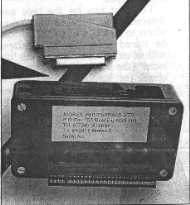
the connectors, routine addresses within software and hints on getting problematical equipment moving. Also supplied are a couple of example screen prints and a copy of Tasword, probably the most popular ZX Spectrum word processing package. Software: As provided, the driving software is configured to produce screen copies on the NEC range of printers; however, a simple POKE will set it up for the Epsons. The LLIST and LPRINT commands work with any of the common devices. Morex also provides the information on enabling or disabling token printing and automatic Line Feeds. The serial interface can be configured in much the same way with a wide range of baud rates being catered for. Once the software has been adapted the altered program can be SAVEd as a permanent copy. The screen copy software allows both 'single-size' and 'double-size' copies of the screen to be made; the latter are really very impressive. Price: £48.60 including one cable. £13.40 for second cable. £4.80 for alternative software. Summary: Despite its ragged appearance, the Morex unit offers the |
ADS Centronics Interface 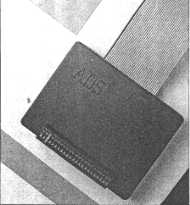
Hardware: A slim, vertical mounting unit housed in a custom-made casing. Even neater to look at than the |
Kempston, the interface is excellently
constructed internally. The attention
to detail is very high; the power supply to each of the seven ICs is filtered
by its own capacitor, but on the sample submitted some of the soldering
left a little to be desired. The interface
lead is some 1.5 metres long and not
detachable from the interface. Also,
no provision has been made for other
interfaces to cascade from the rear of
the unit. Manual: Four A4 pages of matrix quality printout provide a substantial amount of detail, although some of it needs reading two or three times. It gives a full explanation of where the software is located and hints are provided on how to alter the COPY routine to suit printers other than Seikoshas. Software: Two routines are provided on tape: one to do simple text listings and the other to give high resolution screen dumps on to a Seikosha GP250X printer. The text printing routine allows the token expansion to be suppressed in order to send control codes. As the software is fully relocatable, it's possible to fit it anywhere, though normally it loads into memory and then relocates to the |
top before setting RAMTOP to protect itself. ADS is currently working
on an upgraded version of the high
resolution dump software to give full
colour screen images through the
Seikosha GP700A printer. Price: £34.50, all inclusive. Summary: A superb unit, equal in many ways to the Kempston, but slightly let down by the provision of supporting high resolution dump software for only one range of printers. Hilderbay Professional Printer Interface 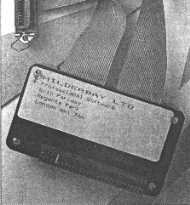
Hardware: Housed in the same kind of box as the Morex interface, this vertically mounted unit also suffers from the aesthetic point of view. However, it more than makes up for that by the features it includes. Equipped with two Centronics leads, one short and the other a generous 1.5 metres, it also acts as a printer spooler. The internal design is messy and the attention to detail during construction looks poor; at least two of the internal straps were in danger of shorting out to IC legs. The chip count is small: an 8255, a 4071 and an unidentified device are all that reside on the PCB. A 3.5mm socket is also provided on the unit; this intercepts the EAR lead to the ZX Spectrum and does away with the hassle of having to remember to unplug it each time you do a SAVE. Manual: Seven A4 pages cover everything about the interface, including the various graphics dump routines (although quite who would have the patience to wait while a Juki daisywheel printer does a screen dump is beyond me!). Software: The review sample came with a full driver which resides in normal memory and a smaller mini- driver which lives in the printer buffer. The penalty paid for using the smaller version is that all the control codes are trapped, so specific POKEs must be issued to get the printer to operate in other fonts or modes. A second tape, together with two sheets of documentation, covered the use of the interface as a spooler. Here | |||||||||||||||||||||||||||||||||||||||||||||||||||||||||||||||||||||||||||||||||||||||||||||||||||||||||||||||||||||||||||||||||||||||||||||||
| |||||||||||||||||||||||||||||||||||||||||||||||||||||||||||||||||||||||||||||||||||||||||||||||||||||||||||||||||||||||||||||||||||||||||||||||||
The printer spooler idea can be taken even further by allowing the ZX Spectrum to perform some post processing on the text that it's storing. One such program is being developed to allow true justification with proportionally spaced text. Developed for Diablo-type daisywheel printers, it unfortunately doesn't allow buffering at the same time ... still, you can't have everything. Price: £99.00 all inclusive. Summary: For reasons known entirely to itself, the Hilderbay unit |
declined to operate as a spooler with
an Apple DMP, although its performance as a standard interface was
flawless. As the great strength of the
professional unit is that it can operate
as a spooler, this was a little
disappointing. While the interface as it stands is as good as any of the others, it's the possibility of using it as a buffer that makes it stand out from the crowd. If you already own a bigger computer and just use the ZX Spectrum for games or for children to learn on, then this interface offers both real printing on the ZX Spectrum and time saving for your bigger machine. Overall Summary Of the three standard units Kempston, ADS and LPRINT Mk II - the latter inherently has the advantage of on-board software, giving it greater speed and more flexibility. Between the other two the ADS is slightly the neater but the Kempston is supplied with a better range of driver software and virtually everything works with it directly. The two 'up-market' units both have advantages in their own ways. For serial printers there is no option but to choose the Morex unit. It offers parallel as well and comes complete with an excellent manual; if pushed, it probably represents the 'Best Buy'. |
It's a shame about the packaging - fit
a nice box around it and you'd have a
real winner. The Hilderbay unit stands or falls on its usage. If there is a need in your life for a printer buffer - and you already have a ZX Spectrum - then this interface will satisfy both requirements. It's also rather cheaper than having to fork out £230 for a 64K printer buffer! As a standard interface it offers nothing special, apart from direct compatibility with all of Hilderbay's software. There are other printer interfaces around - for instance, Softest offer one especially for the Tandy CGP-115. However, as it's a serial-only interface and all the others seem to drive the device quite well, I'm not sure about its value. Unfortunately, the promised review unit failed to appear by the deadline for this survey so no further comment is possible. The interface you choose should really reflect the uses to which it is going to be put. If all you want is a simple-to-use means of getting a proper printout then the ADS, LPRINT Mk II and Kempston units offer just what you are looking for, provided that the driving software is available. More sophisticated users will find the Morex unit well worth a look and those with other computers to support will find the Hilderbay device attractive from the printer spooler viewpoint. |
| Home | Contents | KwikPik |